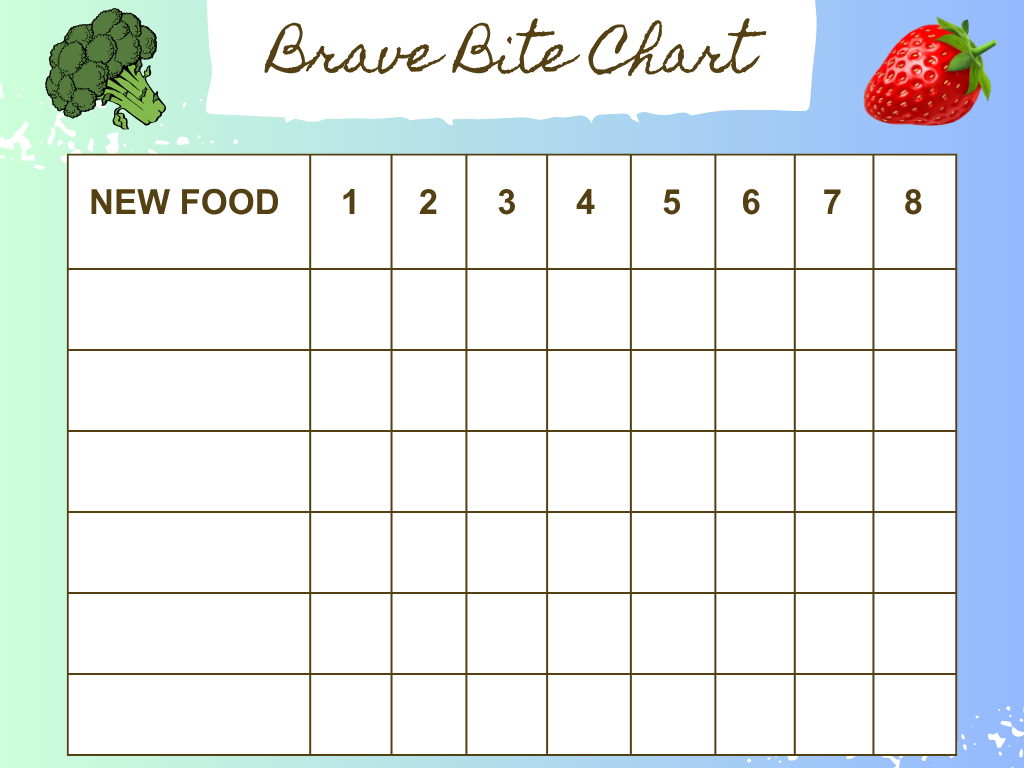Picky Eaters: Causes, Tips, and the Helpful Diets for Kids, Toddlers, and Children with Autism

If you're dealing with a child who refuses anything green, turns their nose up at new foods, or insists on eating the same meal every day, you're not alone. Picky eaters are incredibly common—especially in toddlers and children with sensory processing issues or autism. The good news? With the right strategies, you can increase food variety and improve nutrition in your child's diet. This supplemental guide offers insights into the causes of picky eating, practical tips for picky eaters, and the best diets to support even the most selective little eaters.
Whether your child is simply going through a phase or struggling with underlying issues like sensory sensitivities or food allergies, this guide is packed with helpful information to support your journey. Combine these strategies with our free Brave Bite Chart—a downloadable picky eater chart—to make trying new foods fun and rewarding.
Common Causes of Picky Eating in Kids
Understanding why your child is a picky eater is the first step toward creating a more balanced and enjoyable mealtime routine. Picky eating can be caused by several factors:
1. Sensory Oral Defensiveness or Processing Disorders
Children with sensory sensitivities may be overwhelmed by the textures, smells, and tastes of certain foods. For example, a soft texture like mashed potatoes or a slimy texture like cooked spinach can trigger gag reflexes or refusals. These reactions are often beyond behavioral—it's a physical response to sensory overload.
Some kids may also exhibit oral defensiveness, a condition where textures in the mouth feel unpleasant or even painful. This often leads to a reliance on “safe foods” that they know won’t cause discomfort.
2. Food Allergies and Sensitivities
Food intolerances or allergies can subtly affect a child’s eating habits. Interestingly, some children actually crave the foods they are allergic to, while others avoid them due to discomfort or a distorted taste. For instance, many children with sensitivities to gluten or casein (found in dairy) may show a strong preference for foods like macaroni and cheese, pizza, crackers, or PB&J sandwiches.
Anecdotally, many parents report that eliminating allergens from their child's diet leads to improvements not just in food acceptance but in behavior and overall health. For example, after switching to a gluten-free, casein-free (GFCF) diet, one mother noticed her son went from refusing vegetables to eating them willingly, with fewer tantrums and less stress at mealtime.
3. Lack of Exposure and Routines
Children thrive on routine, and food is no different. If a child hasn’t been regularly exposed to a variety of foods early on, they’re more likely to reject unfamiliar options. Picky eaters often rotate between a few familiar meals, making it harder to introduce healthier choices later. The good news? It’s never too late to help your child build new food experiences.
Tips and Diets for Picky Eaters
When considering the best diet for a picky eater, it’s crucial to think holistically. Nutrition is more than just calories—it’s about supporting development, regulating mood, and enhancing overall well-being. Here are some of the most effective diet strategies:
1. Gluten-Free, Casein-Free (GFCF) Diet
This diet is especially popular among children with autism spectrum disorder (ASD). While the research is mixed, many parents have found that removing gluten (found in wheat, barley, and rye) and casein (found in dairy) from their child’s diet reduces hyperactivity, improves digestion, and increases openness to new foods. This can be common if a child actually has an underlying sensitivity or undiagnosed allergy that may be causing them to crave only eating these foods. You may notice this if a child is on the "yellow diet" consisting of mac n cheese, chicken nuggets, pizza etc. without willingness to try new foods.
2. Gradual Integration of Healthy Foods
If a full dietary overhaul feels overwhelming, start small. Blend nutrient-rich foods into meals your child already enjoys. Some ideas include:
- Adding pureed spinach into spaghetti sauce
- Mixing squash or pumpkin into mac and cheese
- Using a 50/50 mix of whole wheat and regular pasta
- Blending fruit into smoothies for a sweet, nutrient-packed treat
These simple swaps can ease your child into a more balanced diet without overwhelming their senses.
3. Whole-Food Focused Diet
Minimize highly processed foods and focus on whole, single-ingredient items when possible. Keep snacks simple—fresh fruit, roasted vegetables, nuts (if allergy-safe), and lean proteins like turkey or chicken can slowly replace chips, sugary treats, and processed crackers.
Practical Tips to Help Picky Eaters Expand Their Diet
In addition to diet changes, daily practices can also make a big difference. Here are expert-recommended tips to help your child overcome picky eating:
1. Use a Picky Eater Chart Like the Brave Bite Chart
Visual progress trackers like our Brave Bite Chart motivate kids through positive reinforcement. Reward small actions like trying a bite, touching a new food, or even helping cook the meal. You can also use a simple reward chart for kids that also lists foods with an emphasis on trying a new food more than once.
2. Involve Your Child in Food Preparation
Let your child help choose groceries, wash vegetables, stir the bowl, or plate the food. Involvement gives them a sense of control and makes them more willing to try what they’ve helped create.
3. Avoid Pressure and Punishment
Forcing or bribing kids to eat can backfire. Instead, model healthy eating habits, stay calm, and keep offering new foods alongside favorites. It can take 10–15 exposures before a child accepts a new food—patience and consistency are key!

4. Offer Sensory Play with Food
Let kids explore food through play without pressure to eat. Touching, smelling, or even making faces out of fruits and veggies can help desensitize them to unfamiliar textures and smells. There are tons of ideas for crafts with food on Pinterest and other places online!
5. Create a routine around mealtimes
I've seen many families allow children to simply wander around the house taking bites of food whenever they want. I know this is merely a way to try and get a child to eat as much as possible when they are picky, but developing a routine that involves washing hands, then sitting at a kitchen table with food in front of you for an increasing amount of time is super important for creating good eating habits. Your child may only sit for 10 seconds to start, but if you use a visual timer and gradual increase the requirements to simply sit at the table with food in front of the child, over time they will start to be more open to eating new foods.
6. Video Modeling
As part of the routine, I recommend using video modeling like the fun animated video below that shows another child trying new foods. A routine could be like the following:
- Watch picky eating video
- Wash hands
- Sit at the table for predetermined time with visual timer
- Sitting at the table could be simply preferred foods to start then gradually add in a non-preferred food simply on a plate on the table nearby gradually moving it closer, then working on touching the food (sensory play works!), smelling the food, touching the tip of the tongue, and then taking one bite.
- If they don't want to eat the non-preferred food, as the end of the routine you can try having them throw away pieces of the food by touching it and using their hand to throw it away. This gives them an opportunity to touch the non-preferred food.
Final Thoughts: You’re Not Alone in the Picky Eating Journey
Having a picky eater can be stressful, especially when you’re worried about nutrition or suspect sensory issues or allergies. But with tools like the Brave Bite Chart, smart diet modifications, and a lot of encouragement, progress is absolutely possible. By offering structure, flexibility, and lots of positive reinforcement, you'll build a foundation that supports healthy eating habits for life. If your child is really struggling to eat a variety of foods, I highly recommend SOS feeding therapy. You can find a practitioner near you on the website!
If you haven't already, be sure to check out my ebooks, now on Amazon!


